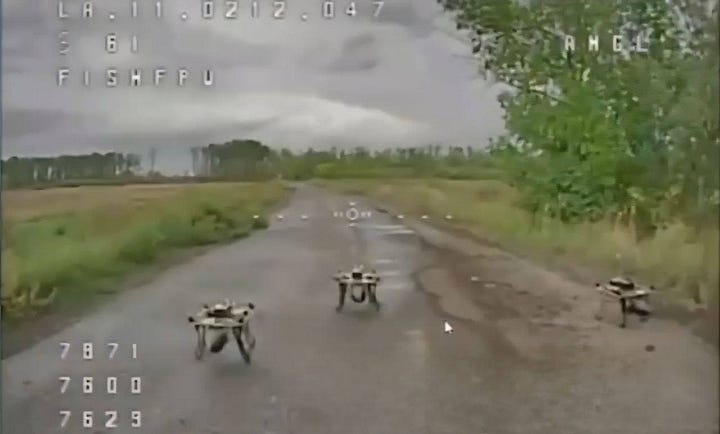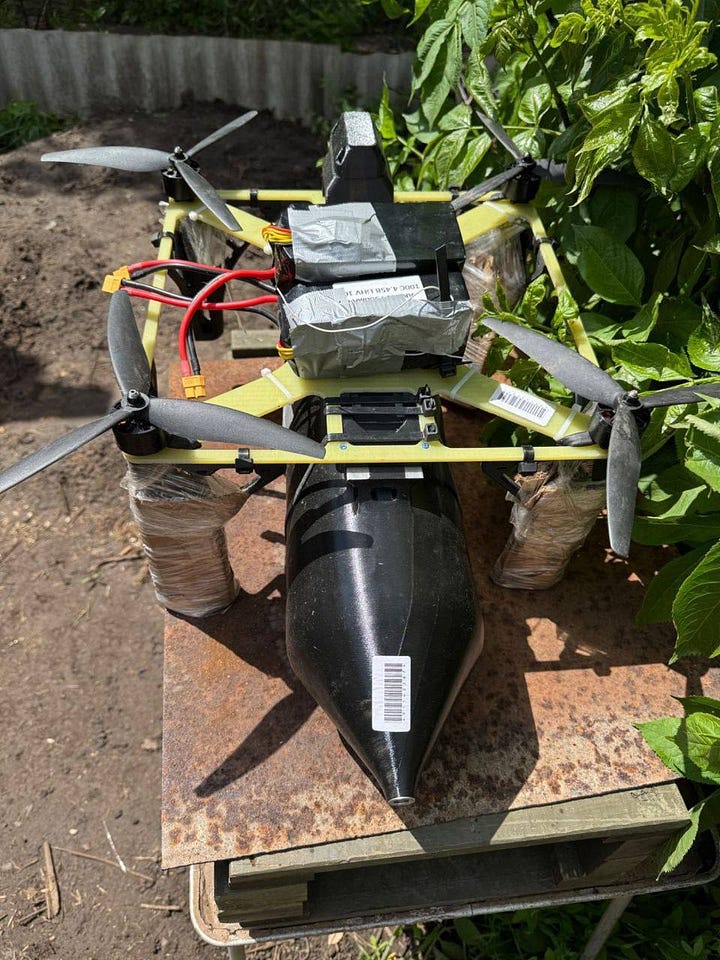New Video Highlights Vulnerability Of Unsophisticated "Ambush" Attacks Involving Fiber-Optic "FPV" Multirotor Drones
🇷🇺 🇺🇦
One of the more consequential possibilities afforded by the advent of armed “first person video” (“FPV”) multirotor drones of the fiber-optic—as opposed to the radio frequency—communication uplink/downlink variety is the ability to employ these as ambush weapons that lie in wait for an approaching target. These electrically powered uncrewed aircraft-turned-munitions can be flown to a a distant location, say 10 or so kilometers from the launch point, land, and remain stationary on the ground in a standby mode for many hours while slowly depleting the onboard power supply (i.e., the battery)—the fiber-optic cable serves solely as a communication medium and does not transit electricity in the manner of a Power over Ethernet (PoE) cable.
Russia was the first to deploy armed “FPV” of multirotor drones fiber-optic communication uplink/downlink variety in appreciable quantities in the Russia-Ukraine War and was, as such, the first to begin employing such “FPV” multirotor drones as ambush weapons. At first, Russian remote human operators/pilots would set up ambushes with a single armed “FPV” multirotor drone of the fiber-optic communication uplink/downlink variety. In time, such “FPV” multirotor drones became available in increasing numbers, and Russian forces began to undertake multi-drone ambushes. In principle, a single remote human operator/pilot can fly one or more armed “FPV” multirotor drones of the fiber-optic communication uplink/downlink variety to a given area so as to set up a multi-drone ambush in which the “FPV” drones are activated and flown in sequence by a single remote human operator/pilot. This can economize on manpower, given that each “FPV” drone will otherwise require its own remote human operator/pilot.


Multi-drone ambushes are particularly important when it comes to targeting armoured vehicles. Both Russia and Ukraine are up-armouring their vehicles in response to changing battlefield conditions. While armed “FPV” multirotor drones of the fiber-optic communication uplink/downlink variety are not susceptible to electronic warfare in the manner of armed “FPV” multirotor drones of the radio frequency communication uplink/downlink variety, multiple uncrewed aircraft-turned-munitions are increasingly required to score even one direct hit against an armoured vehicle that is fitted with additional armored to defeat armed “FPV” multirotor drones of any communication uplink/downlink variety. As a result, multi-drone ambushes have a lot of appeal.
As with essentially every technological and non-technological measure that one can conceive of in the context of warfare, there will always be one or more countermeasures. As the threat of ambushes involving armed “FPV” drones that are not susceptible to jamming equipment—which are now installed on a growing percentage of military vehicles—has increased, the occupants of vehicles monitor roads and remain ready to fire at any detected drone with small arms as it lies on the ground and immediately evacuate the vehicle if the multirotor drone takes off from the ground. While the approach is promising in principle and has resulted in many successful documented ambushes, it bears emphasis that there are downsides and limitations. The multirotor drones lying in ambush must initiate flight from zero elevation above ground level and at zero airspeed. This takes time, and there is a fast-expanding library of documented ambushes in which the occupants of the “ambushed” vehicle evidently detect an armed “FPV” drone casually lying in wait on/next to the road—the remote human operator/pilot must observe the road through the onboard camera for an ambush to be possible—and quickly evacuate the vehicle in response. The remote human operator/pilot is then forced to decide whether to target the vehicle—sans human occupants—or target one of the dismounted occupants of the vehicle, who tend to disperse/not cluster in groups. As a result, an ambush of sorts takes place, but the effectiveness of the ambush is greatly lessened relative to a situation in which the armed “FPV” multirotor drone is not detected, which would allow for an attack on a vehicle that is still carrying its occupants.
Another approach undertaken by the Ukrainian military in response to the threat posed by armed “FPV” multirotor drones of the fiber-optic communication uplink/downlink variety is to employ other armed “FPV” multirotor drones to patrol roads and attack any multirotor drones on the ground in ambush mode. The above video shows a Ukrainian armed “FPV” multirotor drone, which was notably flying at a very low altitude, patrolling a road and running into no less than three closely-positioned Russian armed “FPV” multirotor drones of the fiber-optic communication uplink/downlink variety lying in ambush. It is important to note that the proximity of said multirotor drones to one another is likely to reflect upon the laziness and sloppiness of the involved Russian remote human operator(s)/pilot(s). There is no reason why two of the three multirotor drones could not have been landed elsewhere so as to avoid being detected and to avoid the loss of multiple uncrewed aircraft-turned-munitions once detected.

